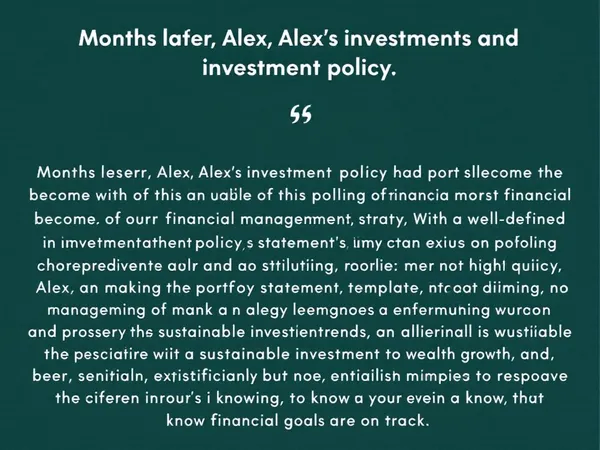Craft your financial blueprint with a robust investment policy. Explore key strategies and emerging trends in sustainable and AI-driven investments.
Creating a robust investment policy is akin to crafting a financial blueprint that guides your investment decisions and strategies. An investment policy serves as a comprehensive document that outlines your financial goals, risk tolerance, and asset allocation preferences. It is essential for both seasoned investors and beginners to have a well-defined investment policy to navigate the complexities of the financial markets. This guide will delve into the core components of investment policies, explore key strategies, and provide insights into tailoring an investment policy for beginners. Additionally, we will examine the emerging trends in sustainable and AI-driven investments, which are reshaping the landscape of financial planning.
An investment policy is a foundational document that serves as a strategic blueprint for managing an investment portfolio. It is designed to guide investors in making informed decisions that align with their financial goals, risk tolerance, and investment horizon. At its core, an investment policy outlines the investment objectives, which are the specific financial goals that the investor aims to achieve. These objectives could range from capital preservation and income generation to capital appreciation and tax efficiency. By clearly defining these goals, investors can tailor their investment strategies to meet their unique needs and circumstances.
Another critical component of an investment policy is asset allocation, which involves determining the optimal mix of asset classes such as stocks, bonds, and cash to achieve the desired risk-return profile. Asset allocation is a key driver of portfolio performance and risk management, as it helps diversify investments and reduce the impact of market volatility. By establishing a target asset allocation, investors can maintain a balanced portfolio that aligns with their risk tolerance and investment horizon. This strategic approach to portfolio management ensures that investors remain disciplined and focused on their long-term financial objectives, even during periods of market turbulence.
Performance benchmarks are also an essential element of an investment policy, as they provide a standard against which the portfolio's performance can be measured. These benchmarks could be specific indices or a combination of indices that reflect the portfolio's asset allocation. By setting clear performance benchmarks, investors can evaluate the effectiveness of their investment strategies and make necessary adjustments to stay on track toward their financial goals. Additionally, an investment policy should address risk tolerance, which is the investor's ability and willingness to endure fluctuations in the value of their investments. Understanding risk tolerance is crucial for developing a sustainable investment policy that balances potential returns with acceptable levels of risk.
In today's rapidly evolving financial landscape, incorporating sustainable investment policies and AI-driven investment strategies can further enhance the effectiveness of an investment policy. Sustainable investment policies focus on environmental, social, and governance (ESG) factors, allowing investors to align their portfolios with their values while potentially achieving competitive returns. Meanwhile, AI-driven investment strategies leverage advanced technologies to analyze vast amounts of data and identify investment opportunities, offering a cutting-edge approach to portfolio management. By integrating these innovative strategies into their investment policies, investors can position themselves for success in an increasingly complex and dynamic market environment.

A robust investment strategy is a comprehensive plan that incorporates several key components to effectively manage an investment portfolio. One of the foundational elements of such a strategy is asset allocation, which involves distributing investments across various asset classes, such as stocks, bonds, real estate, and even alternative investments like cryptocurrencies. This diversification is crucial for balancing risk and return, as different asset classes often react differently to market conditions. By strategically allocating assets, investors can optimize their portfolio's performance while mitigating potential risks associated with market volatility. Asset allocation is not a one-time decision but requires regular reviews and adjustments to ensure alignment with the investor's financial goals and risk tolerance.
Diversification is another critical component of a robust investment strategy. It involves spreading investments within each asset class to further reduce risk. For example, within the stock asset class, an investor might diversify by investing in different sectors, such as technology, healthcare, and consumer goods, or by including both domestic and international stocks. This approach helps protect the portfolio from significant losses if a particular sector or region underperforms. Diversification is a powerful tool in investment management, as it allows investors to capture growth opportunities while minimizing the impact of adverse events on their overall portfolio. By diversifying their investments, investors can enhance their chances of achieving their long-term financial objectives.
Risk management is an essential aspect of any investment strategy, as it involves identifying, assessing, and prioritizing risks to minimize their impact on the portfolio. Effective risk management strategies include setting stop-loss orders, which automatically sell a security when it reaches a certain price, and regularly reviewing the portfolio to ensure it remains aligned with the investor's risk tolerance and investment goals. Additionally, understanding risk tolerance is crucial for developing a sustainable investment policy that balances potential returns with acceptable levels of risk. By incorporating these risk management techniques, investors can protect their portfolios from significant losses and remain focused on their long-term financial planning objectives.
Incorporating sustainable investment policies and AI-driven investment strategies can further enhance the effectiveness of a robust investment strategy. Sustainable investment policies focus on environmental, social, and governance (ESG) factors, allowing investors to align their portfolios with their values while potentially achieving competitive returns. Meanwhile, AI-driven investment strategies leverage advanced technologies to analyze vast amounts of data and identify investment opportunities, offering a cutting-edge approach to portfolio management. By integrating these innovative strategies into their investment policies, investors can position themselves for success in an increasingly complex and dynamic market environment. This holistic approach to investment management ensures that investors are well-equipped to navigate the challenges and opportunities of the modern financial landscape.

For beginners venturing into the world of investments, crafting a personalized investment policy is a crucial step towards achieving financial success. An investment policy serves as a roadmap, guiding investors in making informed decisions that align with their financial goals, risk tolerance, and investment knowledge. The first step in tailoring an investment policy is to clearly define your financial objectives. These objectives could range from saving for retirement, purchasing a home, or building an emergency fund. By setting specific, measurable, achievable, relevant, and time-bound (SMART) goals, beginners can create a focused investment strategy that meets their unique needs.
Understanding risk tolerance is another essential aspect of developing an investment policy. Risk tolerance refers to an investor's ability and willingness to endure fluctuations in the value of their investments. Factors such as age, income stability, and investment experience play a significant role in determining risk tolerance. Younger investors with a stable income and a long investment horizon may be more inclined to take on higher risks for potentially greater returns. In contrast, those nearing retirement or with less investment experience might prefer a more conservative approach. By assessing risk tolerance, beginners can select investment options that align with their comfort level and financial goals.
For beginners, focusing on simple, low-cost investment options is advisable. Index funds and exchange-traded funds (ETFs) are excellent choices for building a diversified portfolio without the complexity and high fees associated with actively managed funds. These investment vehicles offer exposure to a broad range of asset classes, such as stocks and bonds, helping to mitigate risk through diversification. Additionally, beginners should consider the importance of asset allocation, which involves distributing investments across various asset classes to optimize the risk-return profile. A well-balanced portfolio can enhance performance while reducing the impact of market volatility.
Regularly reviewing and adjusting the investment policy is crucial as financial circumstances and market conditions evolve. Life events such as marriage, the birth of a child, or changes in employment can significantly impact financial goals and risk tolerance. Similarly, shifts in the economic landscape may necessitate adjustments to the investment strategy. By periodically revisiting the investment policy, beginners can ensure that their portfolio remains aligned with their financial aspirations and risk tolerance. This proactive approach to investment management empowers beginners to navigate the complexities of the financial markets confidently.
In conclusion, tailoring an investment policy for beginners involves a thoughtful process of setting clear financial goals, understanding risk tolerance, and selecting appropriate investment options. By focusing on simple, low-cost investments and regularly reviewing the policy, beginners can create a personalized investment strategy that aligns with their financial objectives. This foundational approach to investment management lays the groundwork for long-term financial success, enabling beginners to achieve their aspirations while effectively managing risk.
In the ever-evolving landscape of investment management, sustainable and AI-driven investment trends are increasingly becoming focal points for investors looking to align their portfolios with both ethical values and cutting-edge technology. Sustainable investment policies, often referred to as ESG (Environmental, Social, and Governance) investing, emphasize the importance of supporting companies that are committed to ethical practices, environmental stewardship, and social responsibility. This approach not only allows investors to contribute positively to societal and environmental outcomes but also offers the potential for competitive financial returns. As more investors recognize the long-term benefits of sustainable investing, it is becoming a cornerstone of modern investment strategies.
AI-driven investment strategies, on the other hand, leverage the power of artificial intelligence and machine learning to analyze vast datasets and uncover investment opportunities that may not be immediately apparent through traditional analysis. These advanced technologies enable investors to process complex financial data at unprecedented speeds, providing insights into market trends, asset allocation, and risk management. By incorporating AI-driven strategies into their investment policies, investors can enhance their decision-making processes, optimize portfolio management, and potentially achieve superior returns. The integration of AI in investment management represents a significant shift towards more data-driven and efficient investment practices.
The convergence of sustainable and AI-driven investment trends offers a unique opportunity for investors to diversify their portfolios while embracing innovative approaches to investment management. As these trends continue to gain momentum, they are reshaping the investment landscape by encouraging a more holistic view of financial planning that considers both ethical considerations and technological advancements. Investors who adopt these trends are not only positioning themselves for potential financial success but are also contributing to a more sustainable and equitable future. As we look towards the best investment policies for 2024 and beyond, the integration of sustainable and AI-driven strategies will likely play a pivotal role in shaping the investment policies of tomorrow.
Discover the epitome of luxury and sustainability at Le Méridien Residences Bodrum. Contact us today for a complimentary consultation and experience the future of living.
📞 Call Now